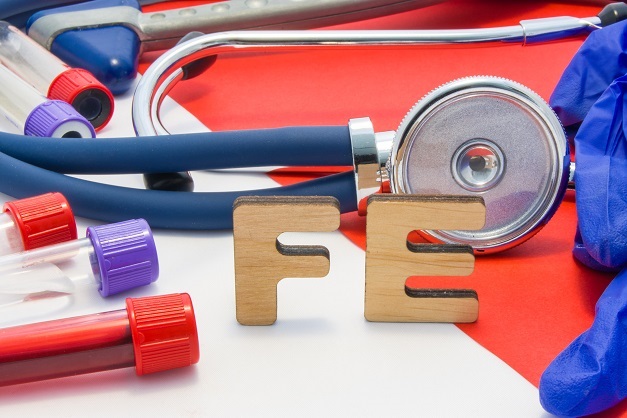“Early diagnosis and treatment is important at reducing the long term complications of the condition – especially for the sake of your joints!”
 Last week was World Haemochromatosis Week and so naturally, my inbox became very popular. Why may you ask? Did you know of the link between arthritis and hereditary haemochromatosis (HH)? In this month’s Ask Kat blog, I will be answering many of your questions about HH, arthritis and why it is important to seek medical advice sooner rather than later. But first, here is some basic information about HH, its symptoms, diagnosis and treatment.
Last week was World Haemochromatosis Week and so naturally, my inbox became very popular. Why may you ask? Did you know of the link between arthritis and hereditary haemochromatosis (HH)? In this month’s Ask Kat blog, I will be answering many of your questions about HH, arthritis and why it is important to seek medical advice sooner rather than later. But first, here is some basic information about HH, its symptoms, diagnosis and treatment.
What is Haemochromatosis?
Haemochromatosis is the most common genetic disorder in Australia. About 1 in 200 people of northern European origin have the genetic risk for haemochromatosis. People with haemochromatosis absorb too much iron from their diet. The extra iron accumulates and is stored in the body’s organs e.g., liver, heart, pancreas, and/or joints. The iron stored in organs or joints can lead to ‘iron overload’ and cause significant damage.
What are the symptoms?
The symptoms of haemochromatosis can vary from person to person. Early haemochromatosis often has no symptoms. As iron slowly builds up in the body over many years, symptoms may begin to be noticed, usually after the age of 40. Symptoms of haemochromatosis can include:
- Fatigue, weakness and lethargy
- Joint pains leading to osteoarthritis
Other symptoms include:
- Abdominal pain
- Diabetes
- Liver disorders; enlarged liver, cirrhosis
- Sexual disorders; loss of sex drive in both male and female, impotence in men, absent or scanty menstrual periods and early menopause in women
- Decrease in body hair
- Discolouration or bronzing of the skin
- Cardiomyopathy; disease of the heart muscle
- Neurological/psychiatric disorders; impaired memory, mood swings, severe irritability, depression
No two people are alike and will present with the same symptoms, in fact, some people don’t display any symptoms!
Diagnosis and Treatment
Since symptoms are caused by too much iron in the body, a simple way to assess this is a blood test. In particular, one indicator of the level of iron stored in your body is serum ferritin (transferrin saturation is also another important part of the picture for diagnosis). If iron stores are high the serum ferritin level will be high. The normal range is 20 – 300 micrograms per litre (µg/L) for men and 10 – 200 µg/L for women. However, this isn’t a conclusive or gold standard test for HH since serum ferritin levels can also be raised by other factors. Furthermore, iron indicators (serum ferritin and transferrin saturation) may not be elevated even if you have HH. Instead, your GP will need to request the test “HFE mutation analysis” which determines mutations identified in the HFE (haemochromatosis) gene. These are called C282Y and H63D. When patients have two copies of C282Y (one from each parent), they have HH. If they only have one copy of the C282Y, they are a carrier.
While HH cannot be cured, it can be easily treated and people can go on to live a normal and healthy life if diagnosed and treated early. Treatment consists of the removal of blood by venesection (similar to donating blood). This is also sometimes called phlebotomy. Up to 500mL of blood is removed at regular intervals until the iron levels in the blood return to within the normal range. Depending on initial iron levels, it may take up to 18 months with weekly or sometimes twice weekly venesections to return iron indicators back to normal. Once normal levels of iron are re-established, venesections are used less frequently (three or four times a year) to maintain those levels throughout the patient’s lifetime.
For information about the condition, watch this 2min video from Haemochromatosis Australia https://youtu.be/MxGUAafNSnI
Important information about HH and Gender HHHHH
Please note that just because symptoms may not present until your 40s, does not mean it’s nothing to worry about until then – especially in the case of men. Even though haemochromatosis affects men and women equally, in regard to the inheritance of the haemochromatosis gene, male patients usually have a higher prevalence of cirrhosis and other symptoms compared with female patients. This is likely due to the fact that over their lifetime, men do not regularly lose blood through regular menstruation or go through child birth (where there can be significant blood loss). Since HH can be a ‘silent’ condition, that is, it may not present with any symptoms and for a long time too, if you know there is a family history of HH, then it is a good idea to get tested. If there is a family history and/or your blood iron indicators are significantly high, the gene test is free in Australia.
Important information about HH and Arthritis HHHHH
If high levels of iron are sustained over a long period of time, iron can be deposited into organs (e.g. liver, heart) or joints and cause damage. There is no way to tell whether iron will be stored in organs or joints, although organs seem to be affected more often. Arthropothy (disease of the joints/arthritis) was initially considered to be a late feature of the disease, however, current research is finding joints are being affected more than once thought. Arthropathy has been increasingly recognised as an early manifestation and the predominant clinical factor affecting the quality of life of patients with haemochromatosis. Recent data confirms the high prevalence of joint symptoms in haemochromatosis predating the diagnosis by many years. For example, a study found a diagnosis of haemochromatosis was made at a mean age of 52.8 and 76% of the participants reported joint symptoms with a mean duration of 8 years (1). In this particular study, the most common affected joints were (in order) finger and hand joints, knee, hip and ankle (1).
Organs vs joints
Venesection is very effective at reducing iron levels, and indirectly allows for any damaged organs to heal. A venesection removes blood from the body which triggers bone marrow to make more red blood cells (RBCs). Iron, among folate and B12, is an important ingredient in making new RBCs. If there is iron stored in organs, the body will take or ‘leech’ that iron to help generate more RBCs. In doing so, this process removes stored iron from the organ/s and allows the organ to heal. In this context, there is a two way street between iron storage and organs – iron can ‘get in’ and ‘get out’. Unfortunately, this isn’t the case for joints and joint tissues. For unknown reasons, it’s a one way street for iron storage and joints. When iron ‘gets in’ to the joints, regardless of venesection, it can’t ‘get out’, which means the joint and joint tissues cannot heal. This is why early detection is so important. Joint damage from haemochromatosis does not tend to disappear – it’s degenerative, even if iron levels return to normal with treatment. People with joint damage often have ongoing pain, stiffness and difficulties using their joints – it is very similar to a typical osteoarthritis (OA) presentation. One study, albeit from 1996, indicated that the symptoms of arthropathy improve in up to 30% of patients after removal of excess iron; they worsen in 20% and are unaffected by treatment in the rest (2). Damage to joints from HH usually require similar, if not the same, treatment as non-haemochrotic arthritis i.e., medicines, physiotherapy, aids/gadgets and lifestyle changes. Arthritis caused by haemochromatosis rarely causes severe disability but, when it does, surgery to replace joints may be necessary.
Have a listen to Desma and her story. Produced by Haemochromatosis Australia, this short clip provides valuable insight into how HH can cause arthritis and potential outcomes. https://youtu.be/UpeXKD2Kx0c
A few other things:
- Haemochromatosis may present with arthropathy without the more recognisable features of the disease and that the diagnosis is easily overlooked in patients presenting with exercise related joint pains if symptoms are attributed solely to their exercise and sporting activities
- Although dietary iron is the source of excess iron in haemochromatosis, a decrease in dietary iron has not been shown to decrease iron stores in haemochromatosis. You can eat a normal, well rounded diet without leaving iron rich foods out. However, Hemochromatosis patients are advised to avoid iron supplementation and large doses of supplemental oral vitamin C which may adversely affect some patients with iron overload (Vit C aids the uptake of the Iron in the gut).
Case studies (if you’re game!)
Here is a link to a case study paper. It includes the case study two demographically different people and their outcome. https://www.ncbi.nlm.nih.gov/pmc/articles/PMC1114910/ (Warning- while this is a scientific study, the two case presentations at the beginning of the paper are fairly easy to read)
Lastly, see a GP if you have:
- Persistent or worrying symptoms that could be caused by HH (see above)- especially if you have a northern European family background, as the condition is most common in this group
- A parent or sibling with HH, even if you don’t have symptoms yourself
Screening for the disease is simple, and early diagnosis and treatment can prevent the development of serious, irreversible complications.
For more information about haemochromatosis please visit https://haemochromatosis.org.au/
Arthritis NSW – we’re here to help
We’re here to help whenever you need us. We have a variety of options available for support and information.
- For more BLOG articles about managing your arthritis, please visit our News page here.
- Sign up to eNews to get information and advice on managing your condition
- Call our free helpline on 1800 011 041 (Monday to Friday, 9am to 5pm)
- Join our online community: Follow us on Facebook or Instagram
- Subscribe to our magazine, more info here
- Become a member, more info here
References
- Richardson, A., Prideaux, A., & Kiely, P. (2017). Haemochromatosis: unexplained metacarpophalangeal or ankle arthropathy should prompt diagnostic tests: findings from two UK observational cohort studies. Scandinavian journal of rheumatology, 46(1), 69-74. https://doi.org/10.3109/03009742.2016.1155645
- Niederau C, Fischer R, Purschel A, Stremmel W, Häussinger D, Strohmeyer G. (1996). Long-term survival in patients with hereditary hemochromatosis. Gastroenterology, 110(4), 1107-1119. https://doi.org/10.1053/gast.1996.v110.pm8613000
- Haemochromatosis Australia https://haemochromatosis.org.au/
- Beaton, M. D., & Adams, P. C. (2007). The myths and realities of hemochromatosis. Canadian Journal of Gastroenterology and Hepatology, 21(2), 101-104. https://doi.org/10.1155/2007/619401
